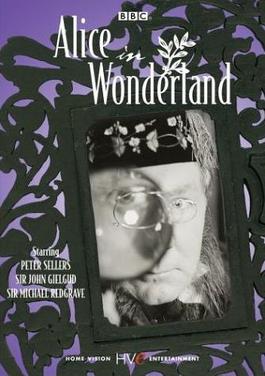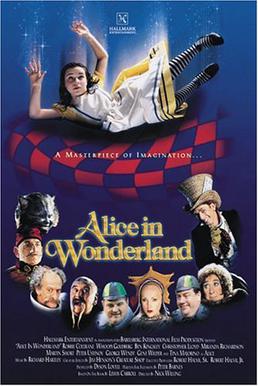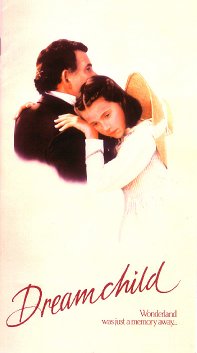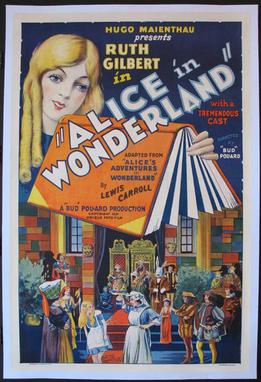
Alice's Adventures in Wonderland is an 1865 English children's novel by Lewis Carroll, a mathematics don at Oxford University. It details the story of a young girl named Alice who falls through a rabbit hole into a fantasy world of anthropomorphic creatures. It is seen as an example of the literary nonsense genre. The artist John Tenniel provided 42 wood-engraved illustrations for the book.

The Hatter is a fictional character in Lewis Carroll's 1865 book Alice's Adventures in Wonderland and its 1871 sequel Through the Looking-Glass. He is very often referred to as the Mad Hatter, though this term was never used by Carroll. The phrase "mad as a hatter" pre-dates Carroll's works. The Hatter and the March Hare are referred to as "both mad" by the Cheshire Cat, in Alice's Adventures in Wonderland in the sixth chapter titled "Pig and Pepper".

The Queen of Hearts is a fictional character and the main antagonist in the 1865 book Alice's Adventures in Wonderland by Lewis Carroll. She is a childish, foul-tempered monarch whom Carroll himself describes as "a blind fury", and who is quick to give death sentences at even the slightest of offenses. One of her most famous lines is the oft-repeated "Off with his/her head!" / "Off with their heads!"

The White Rabbit is a fictional and anthropomorphic character in Lewis Carroll's 1865 book Alice's Adventures in Wonderland. He appears at the very beginning of the book, in chapter one, wearing a waistcoat, and muttering "Oh dear! Oh dear! I shall be too late!" Alice follows him down the rabbit hole into Wonderland. Alice encounters him again when he mistakes her for his housemaid Mary Ann and she becomes trapped in his house after growing too large. The Rabbit shows up again in the last few chapters, as a herald-like servant of the King and Queen of Hearts.

Alice in Wonderland is a 1966 BBC television play, shot on film, based on Lewis Carroll's 1865 book Alice's Adventures in Wonderland. It was adapted, produced and directed by Jonathan Miller, then best known for his appearance in the satirical revue Beyond the Fringe.
Bill the Lizard is a fictional character appearing in Lewis Carroll's 1865 novel Alice's Adventures in Wonderland.

Alice in Wonderland is a 1999 made-for-television film adaptation of Lewis Carroll's books Alice's Adventures in Wonderland (1865) and Through the Looking-Glass (1871). It is currently the last production to adapt the original stories and was first broadcast on NBC and then shown on British television on Channel 4.

Lewis Carroll's books Alice's Adventures in Wonderland (1865) and Through the Looking-Glass (1871) have been highly popular in their original forms, and have served as the basis for many subsequent works since they were published. They have been adapted directly into other media, their characters and situations have been appropriated into other works, and these elements have been referenced innumerable times as familiar elements of shared culture. Simple references to the two books are too numerous to list; this list of works based on Alice in Wonderland focuses on works based specifically and substantially on Carroll's two books about the character of Alice.

Dreamchild is a 1985 British drama film written by Dennis Potter, directed by Gavin Millar, and produced by Rick McCallum and Kenith Trodd. The film, starring Coral Browne, Ian Holm, Peter Gallagher, Nicola Cowper and Amelia Shankley, is a fictionalised account of Alice Liddell, the child who inspired Lewis Carroll's 1865 novel Alice's Adventures in Wonderland.

Alice's Adventures in Wonderland is a 1972 British musical film based on Lewis Carroll's 1865 novel of the same name and its 1871 sequel, Through the Looking-Glass, directed by Australian television producer-director William Sterling. It had a distinguished ensemble cast with a musical score by John Barry and lyrics by Don Black.

The Dormouse is a character in "A Mad Tea-Party", Chapter VII from the 1865 novel Alice's Adventures in Wonderland by Lewis Carroll.

Alice in Wonderland is a musical by Henry Savile Clarke, Walter Slaughter (music) and Aubrey Hopwood (lyrics), based on Lewis Carroll's books Alice's Adventures in Wonderland (1865) and Through the Looking-Glass (1871). It debuted at the Prince of Wales Theatre in the West End in 1886.

The Knave of Hearts is a character from the 1865 book Alice's Adventures in Wonderland by Lewis Carroll.

The Gryphon is a fictional character devised by Lewis Carroll in the popular 1865 book Alice's Adventures in Wonderland. True to the conventional view of a griffin, he has the head, talons, and wings of an eagle and the body of a lion.

Alice in Wonderland is a 1949 French film based on Lewis Carroll's 1865 fantasy novel Alice's Adventures in Wonderland. Directed by Dallas Bower, the film stars Carol Marsh as Alice, Stephen Murray as Lewis Carroll, and Raymond Bussières as The Tailor. Most of the Wonderland characters are portrayed by stop-motion animated puppets created by Lou Bunin.

Alice in Wonderland (1931) is an independently made black-and-white Pre-Code American film based on Lewis Carroll's 1865 novel Alice's Adventures in Wonderland, directed by Bud Pollard, produced by Hugo Maienthau, and filmed at Metropolitan Studios in Fort Lee, New Jersey.

Wonderland is the setting for Lewis Carroll's 1865 children's novel Alice's Adventures in Wonderland.

"The Mock Turtle's Song", also known as the "Lobster Quadrille", is a song recited by the Mock Turtle in Lewis Carroll's 1865 novel Alice's Adventures in Wonderland, accompanied by a dance. It was taught to him at school by his teacher called Tortoise.
Alice in Wonderland and Through the Looking-Glass is a 2001 stage adaptation of Lewis Carroll's 1865 novel Alice's Adventures in Wonderland, and the 1871 novel Through the Looking-Glass. It was written by Adrian Mitchell.

















